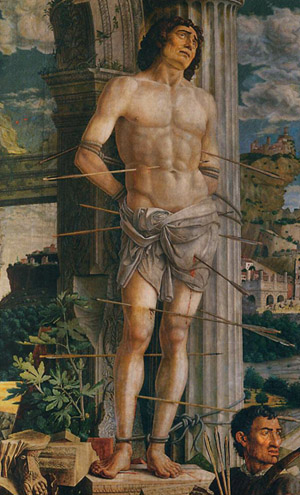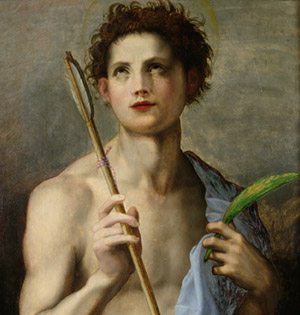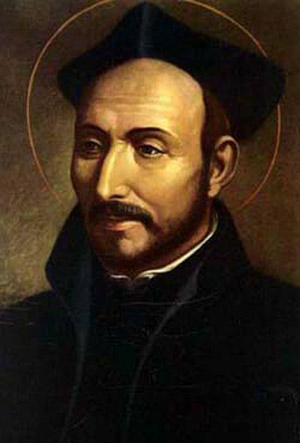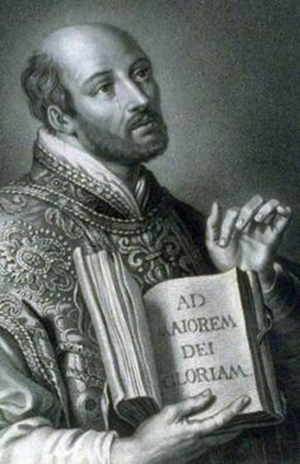 |
The Saint of the Day
St. Erlembald - II - August 3
Prof. Plinio Corrêa de Oliveira
Comments of Prof. Plinio:
(Continued from here) – The life of St. Erlembald gives us the opportunity to distinguish two types of saints in the Church. One is type of saint that approaches the line of our counter-revolutionary vocation; another is the line of normal saints who can more easily be distorted by sentimental piety.
This school of sentimental piety abhors the counter-revolutionary saints or any saint who shines as a warrior for the cause of Christ. It always tries to present them from its own syrup-soaked perspective. In the case of St. Erlembald, for example, I imagine this sentimental mentality would like to describe him as follows:

Above, St. Sebastian portrayed close to reality; below, according to the school of sentimental piety
 |
“Erlembald, the son the Duke of Milan, had a horror of bloodshed from his early childhood. Whenever he saw it or even came upon an injured animal, he would run to his mother’s lap and sigh, ‘Mama, how much sorrow there is in this life.’
"His mother would lead him to a statue nearby to pray and the boy would remain there weeping for a long while. Finally, his tears would stop as he consoled himself with the idea that all suffering will end in Heaven.
“The holy youth was extremely delicate and sickly, with an open sore on his forehead that emitted a bad odor. He grew to have such a horror of earthly things that he resolved to leave everything to dedicate himself to the service of the poor. He was known for his great charity, often washing the feet of the poor and caring for sick animals. He was also celebrated for his peace-making efforts, stepping in to reconcile quarreling parties; for this reason, he was called Erlembald the Peaceful. He died at a very old age with a serene smile on his face and became known as ‘the smiling saint.’”
Please note, I am not saying that a man cannot be an authentic saint with such a biography. God forbid! I am not saying that a saint necessarily is part of this current of sentimental piety. If he is a saint, he is a model of the practice of virtues, who must be admired. But sanctity is not limited to this. What I am condemning is the exclusive presentation of this type as the only possible saint worthy of veneration.
Now then, St. Erlembald was the opposite of this kind of pious person – but he was also a saint.
He had a position of great relevance in his city. Milan is – and always was – one of the principal cities of Italy. It is set in the Valley of the Po River as an intersecting point of many important roads of a very wealthy region of Europe. It is home to a very intelligent, learned, political and artistic people.
To be a Duke of Milan at that time meant to be one of the greatest Heads of State of Italy. At that point in time, the Duke of Milan also played a considerable role in international politics because the Kings of France and the Emperors of the Holy Empire were constantly fighting between themselves, and the support of important Italian cities like Milan could shift the balance of the political scale one way or another. Hence, the Princes of the small principalities of Northern Italy often decided the course of international affairs.
Erlembald is described to us as a healthy man, strong, good-looking, wealthy, who presents himself with grandiosity in the streets, followed by a large retinue. He asserts his authority with his presence and at times exercises it by means of arms. Nonetheless, at a certain moment of his life, he wants to leave all these things to become a monk.
This desire is the only point in his life that the sentimental school of piety likes. But then St. Arialdo enters the picture to destroy the hopes of the sentimental Catholic. He counsels St. Erlembald to not become a monk, but to retain his temporal office. This good counsel that raises our enthusiasm is bitter medicine for the sentimental soul.

Above,
St. Ignatius of Loyola close to reality; below, with dramatic features & gestures to make him look sweet & emotional
 |
St. Erlembald travels to Rome to ask the Pope what he should do. Again, the sentimental Catholic does not appreciate this journey to Rome. Why make such a flamboyant trip? Why didn’t Erlembald simply seek the advice of his parish priest? This is what would please the sentimental current.
The Saint goes to Rome and meets a Saint Pope who gives him a Standard of St. Peter and essentially tells him: “Go with my standard and be my sword against my enemies in Milan!” The sentimental Catholic enters into panic over this mandate: “How can a Pope send this wild beast against the people of Milan! He should have recommended mercy and amiability…”
So, instead of distributing smiles and kisses, St. Erlembald goes back to Milan with ardor and fights against the simoniacal Archbishop Guido, ending by imprisoning him and raising a siege against his illicitly chosen successor, completely destroying him. According to the sentimental Catholic, all priests are good and all Archbishops are holy. To fight against an Archbishop and imprison him is something akin to profanation and blasphemy.
We see that our sentimental Catholic is wrong in his opinions, because Erlembald is a great saint. For the followers of this current of sentimental piety, when a saint appears in a city everyone should convert. Here we see the contrary. The Saint is in Milan – in fact there are two Saints, Erlembald and Arialdo – and very few convert; to the contrary, a large part of the city tries to kill them.
The mission of St. Erlembald raises our enthusiasm because we see in him the sword serving right and justice. He goes out and destroys the evil ones. The Holy Spirit teaches us in the Scripture: “Maledictus homo qui prohibit gladium suum a sanguine” (Cursed be the man who prevents his sword from shedding blood – Jer 48:10). We see that St. Erlembald followed this counsel plentifully. The sentimental Catholic thinks the opposite: Cursed be the man who sheds any blood.
Then, the chief of the heretics – the Archbishop of Milan, Guido of Velate – displays the Papal Bull excommunicating him and, as a precursor to Luther, incites the people against Rome and to murder the two Saints faithful to the Pope. Next, we have a scene of a dogfight inside the Cathedral with the two Saints giving and receiving punches and kicks from both clergy and laity. St. Arialdo is wounded, but no one is able to touch St. Erlembald, who is a lion.
The sentimental Catholic only acknowledges saints who died like St. Stephen. He does not understand and abhors saints like St. Erlembald, who, notwithstanding, fill our souls with joy. We are called to have this type of fight and anyone who does not recognize this cannot understand us. We speak a different language than that of the sentimental Catholics and there is an inevitable misunderstanding when we are together.
So that St. Erlembald would have a greater glory, at the end of his life he also received the grace to die fighting for the Catholic Faith and the Pope after a long life of battles and resistance to evil.
He is truly a Saint worthy of our veneration.


  |
|
Prof. Plinio Corrêa de Oliveira | |
The Saint of the Day features highlights from the lives of saints based on comments made by the late Prof. Plinio Corrêa de Oliveira. Following the example of St. John Bosco who used to make similar talks for the boys of his College, each evening it was Prof. Plinio’s custom to make a short commentary on the lives of the next day’s saint in a meeting for youth in order to encourage them in the practice of virtue and love for the Catholic Church. TIA thought that its readers could profit from these valuable commentaries.
The texts of both the biographical data and the comments come from personal notes taken by Atila S. Guimarães from 1964 to 1995. Given the fact that the source is a personal notebook, it is possible that at times the biographic notes transcribed here will not rigorously follow the original text read by Prof. Plinio. The commentaries have also been adapted and translated for TIA’s site.
|
Saint of the Day | Home | Books | CDs | Search | Contact Us | Donate

© 2002- Tradition in Action, Inc. All Rights Reserved
|
 |

|